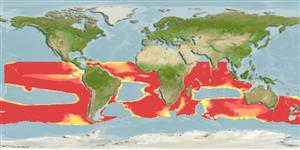Environment: milieu / climate zone / depth range / distribution range
Ecologie
marien bathypelagisch; diepte 1000 - 3300 m (Ref. 75596), usually 1400 - 2500 m (Ref. 75596). Deep-water; 16°N - 60°S (Ref. 75596)
Circumglobal in equatorial, tropical, subtropical, temperate and subpolar regions: Atlantic Ocean (40° N to 40° S); Indian Ocean (from the type locality, 16°56’ N, 92°33’ E); Pacific Ocean (31° N to 43° S); Southern Ocean (50° S-60° S).
Grootte / Gewicht / Leeftijd
Maturity: Lm ? range ? - ? cm
Max length : 26.2 cm SL mannelijk / geslacht onbekend; (Ref. 6944)
Dorsale stekels (totaal): 11 - 14; Dorsale zachte stralen (totaal): 21-25; Anale stekels 1; Anale zachte stralen: 22 - 26. This species is distinguished from its congeners K. falx by the teeth in lateral series of premaxilla 7-11, caniniform, elongated, slightly curved, type 4, widely spaced (vs. teeth in lateral series of premaxilla 13-33; recurved, with ventral attachment, closely spaced in K. parri; needle-like, closely spaced in K. kerberti and K. macrodon and anterior part fourth of K. normani; caniniform but not very elongated in K. colubrina); first tooth of lateral series of premaxilla longest, with tight type 4 attachment (vs. first tooth of lateral series of premaxilla not remarkably enlarged, smaller than adjacent teeth, with loose types 4 attachment or with ventral attachment to bone); teeth in mesial series of premaxilla 3, fang-like (vs. 4 or 15; not fang-like in K. macrura, K. parri, K. colubrina); teeth in lateral series of dentary 6-8, very elongated, curved, type 4, widely spaced (vs. 12-32; recurved, with ventral attachment, closely spaced in K. parri, needle-like, closely spaced in K. kerberti and K. macrodon and anterior part fourth of K. normani; recurved in K. colubrina). This species can be further distinguished from K. falx by the larger eye, orbit width 15.4-22.7% and orbit height 12.5-18% in head length (vs. eye small, orbit width 11.2-16.0% and orbit height 9.7-12.4% in head length); basihyal elongated and straight, pointing forward (vs. basihyal reduced, strongly curved, pointing ventrally); first tooth in lateral series of premaxilla enlarged, 15.2-16.4 % in premaxillary length, slightly curved, not projecting anteriorly (vs. first tooth remarkably enlarged, 17.2-20.5% in premaxillary length, sickle-shaped, projecting anteriorly); first tooth in mesial series of premaxilla anterior to level of anterior nostril, and to second tooth of lateral series (vs. first tooth below level of anterior nostril, and beside second tooth of lateral series); first tooth in mesial series of dentary beside second tooth of lateral series (vs. first tooth between second and third teeth in lateral series) (Ref. 75596).
The shallowest depth record is based on a single Gargaropteron-staged individual which was taken in the Yucatan Channel, in 0-124 m (Museum: RHB 1290).
Levenscyclus en paargedrag
Maturiteit | Voortplanting | Paaien | Eieren | Fecunditeit | Larven
Melo, M.R.S., 2008. The genus Kali Lloyd (Chiasmodontidae: Teleostei) with description of new two species, and the revalidation of K. kerberti Weber. Zootaxa 1747:1-33. (Ref. 75596)
Status op de Rode Lijst van het IUCN (Ref. 130435)
Gevaar voor de mens
Harmless
Gebruik door de mens
Visserij: van geen belang
Meer informatie
Lokale namenSynoniemenMetabolismePredatorenEcotoxicologieVoortplantingMaturiteitPaaienPaaiaggregatiesFecunditeitEierenOntwikkeling van de eieren
ReferentiesAquacultuurAquacultuurprofielKweeklijnenGeneticaElectrophoresesErfelijkheidZiektesVerwerkingNutrientsMassaconversie
Tools
Speciale rapporten
Download XML
Internetbronnen
Estimates based on models
Preferred temperature (Ref.
123201): 1.8 - 4.2, mean 2.5 °C (based on 2804 cells).
Fylogenetische diversiteitsindex (Ref.
82804): PD
50 = 0.5078 [Uniqueness, from 0.5 = low to 2.0 = high].
Bayesian length-weight: a=0.00389 (0.00180 - 0.00842), b=3.12 (2.94 - 3.30), in cm total length, based on all LWR estimates for this body shape (Ref.
93245).
Trofisch niveau (Ref.
69278): 3.8 ±0.2 se; based on size and trophs of closest relatives
Fishing Vulnerability (Ref.
59153): Low vulnerability (22 of 100).
